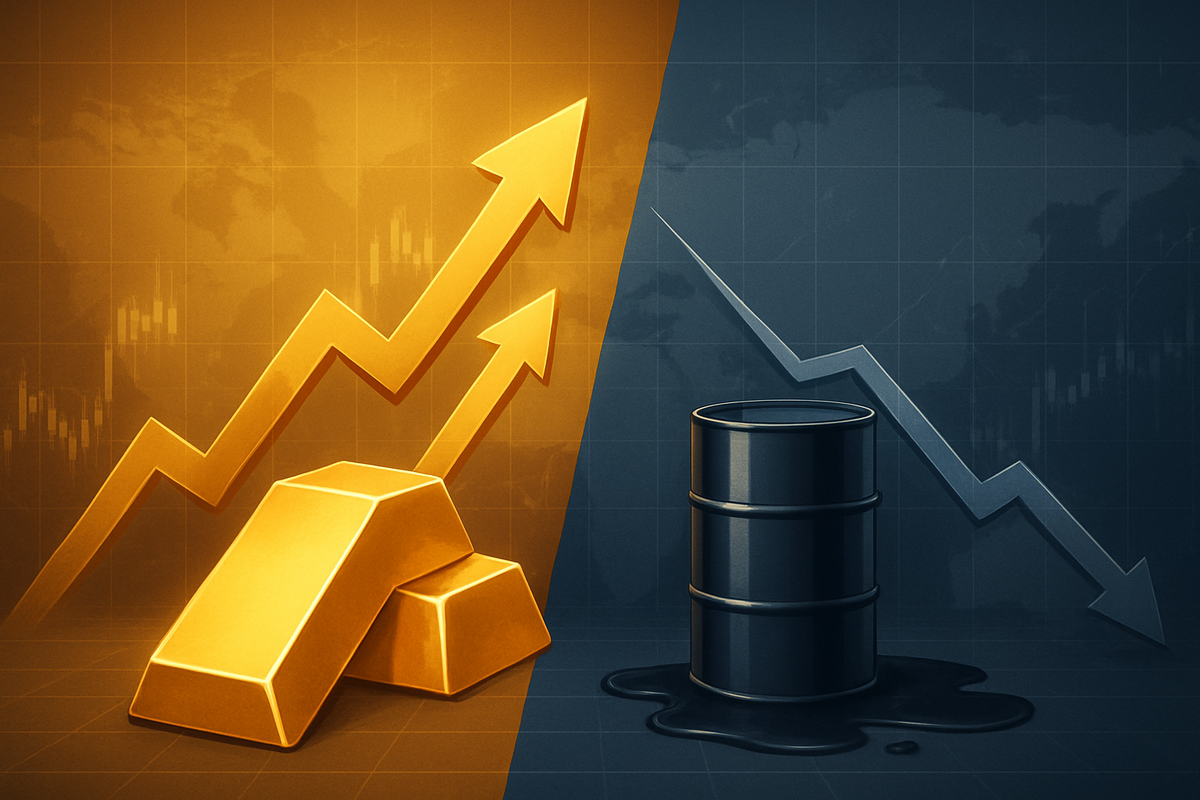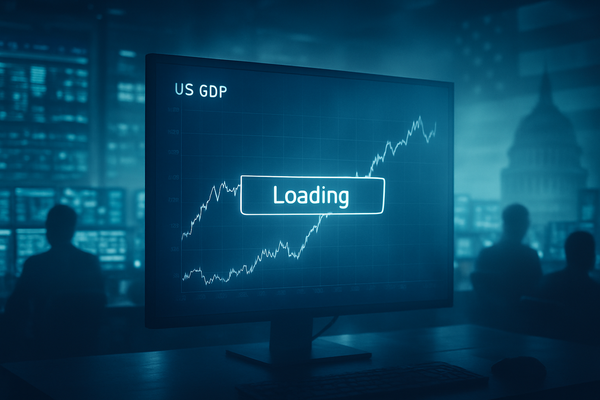Diverging Fortunes: Gold Soars as Oil Dips, Reshaping Global Markets

As of late October 2025, the global financial landscape is witnessing a striking divergence in commodity markets, with gold prices surging to unprecedented highs while crude oil values experience a notable dip. This contrasting movement is sending ripple effects across industries, creating distinct winners and losers, and signaling a heightened sense of risk aversion amidst persistent global uncertainties. The precious metal, long considered a safe haven, has solidified its position, outperforming most asset classes, while the black gold grapples with an oversupplied market, challenging the profitability of energy producers worldwide.
The immediate implications of these diverging trends are profound. Equity markets are experiencing a clear bifurcation, with gold mining companies enjoying a "golden era" of boosted revenues, contrasting sharply with oil exploration and production firms facing tighter margins. This shift reflects a broader reallocation of capital as investors seek refuge from geopolitical instability and monetary policy uncertainties, indicating underlying investor anxiety and a strategic re-evaluation of asset allocation in a turbulent global environment. The interplay between these two critical commodities is not only reshaping market fortunes but also providing crucial insights into the prevailing economic and geopolitical currents.
A Tale of Two Commodities: Gold's Ascent and Oil's Retreat
The narrative of commodity prices in 2025 has been dominated by gold's extraordinary ascent and crude oil's struggle with oversupply. Gold has displayed a remarkable performance, solidifying its role as a premier safe-haven asset. It shattered previous records, surpassing $3,000 per ounce in March 2025 and subsequently breaking through the $4,000 mark in October. On October 21, 2025, gold reached an unprecedented peak of $4,381 per ounce, marking its 45th new all-time high for the year when it hit $4,000/oz on October 8. This surge represents a staggering 54% year-to-date gain, far exceeding most analyst expectations. While a significant 5% single-day correction occurred on October 22, primarily due to profit-taking, the overall bullish outlook for Q4 2025 remains, with some forecasts predicting prices could reach $4,400-$4,500 by year-end.
This robust upward trajectory for gold is underpinned by a confluence of factors. Geopolitical tensions, including ongoing conflicts in the Middle East and Europe, coupled with political instability in various regions such as the US (potential government shutdown), France, and Japan, have fueled intense investment demand for gold as a safe haven. Additionally, expectations of US interest rate cuts by the Federal Reserve and a weakening US dollar have made non-yielding bullion more attractive. A critical driver has also been the consistent increase in gold holdings by central banks globally, seeking to diversify reserves away from the US dollar and mitigate risk in an increasingly uncertain macroeconomic environment.
In stark contrast, crude oil prices have generally trended downwards, experiencing notable dips in the period leading up to October 28, 2025. Brent crude futures decreased to $65.45 per barrel, while U.S. West Texas Intermediate (WTI) crude futures slipped to $61.15 per barrel, extending a three-day downward trend. WTI crude fell further to $59.99 USD/Bbl on the same day, marking a 2.15% daily drop and a 5.45% decline over the past month. The primary driver of these dips is the expectation of an oversupplied market. The Organization of the Petroleum Exporting Countries and allies (OPEC+) is reportedly considering a modest increase in production for December, having already significantly boosted output since April 2025, with Saudi Arabia particularly keen on regaining market share.
Further contributing to the oversupply is the growing U.S. crude oil production, forecasted to average 13.5 million b/d in both 2025 and 2026. The International Energy Agency (IEA) anticipates global oil inventories to rise through 2026, exerting downward pressure on prices, with Brent crude potentially falling to an average of $62 per barrel in Q4 2025 and $52/b in 2026. While temporary rallies occasionally occurred due to geopolitical tensions and sanctions, the dominant force has been the persistent oversupply, shaping initial market reactions and creating a challenging environment for oil producers.
Corporate Fortunes: Winners and Losers in a Shifting Commodity Landscape
The diverging paths of crude oil and gold prices are creating a clear delineation of winners and losers among public companies, significantly reshaping their financial outlooks and strategic priorities.
On the winning side, gold mining companies are experiencing a boom. Firms like Barrick Gold Corp. (NYSE: GOLD) and Newmont Corporation (NYSE: NEM) are seeing their revenues and profit margins expand significantly due to the soaring price of gold. Higher gold prices directly translate to increased profitability for these companies, allowing them to potentially invest in new exploration projects, expand existing operations, or return capital to shareholders through dividends or buybacks. Their stock valuations have generally climbed, attracting investors seeking exposure to the safe-haven asset. The robust demand for gold from central banks and individual investors further solidifies their strong market position. Companies involved in gold streaming and royalty, such as Franco-Nevada Corporation (NYSE: FNV), also benefit immensely from the higher commodity price without incurring the direct operational costs and risks of mining.
Conversely, the dip in crude oil prices is posing significant challenges for oil exploration and production (E&P) companies. Major players like Exxon Mobil Corporation (NYSE: XOM), Chevron Corporation (NYSE: CVX), and numerous smaller independent shale producers are grappling with tighter profit margins. Lower oil prices reduce the revenue generated from each barrel of oil extracted, impacting their cash flow and ability to fund capital expenditures. Some U.S. shale oil producers have already been forced to lower their production forecasts and scale back drilling activities in response to the less favorable price environment. This can lead to job cuts, reduced investment in new technologies, and a slowdown in the energy sector's overall growth. Furthermore, companies heavily invested in specific high-cost extraction methods, such as deep-water drilling or oil sands, may find their projects becoming economically unviable at sustained lower price levels.
Beyond the direct commodity producers, other sectors are also feeling the impact. Airlines and transportation companies, such as Delta Air Lines, Inc. (NYSE: DAL) and United Parcel Service, Inc. (NYSE: UPS), typically benefit from lower crude oil prices as fuel is a significant operational cost. Reduced fuel expenses can lead to improved profitability, which might be passed on to consumers through lower fares or shipping costs, or retained to boost their bottom lines. On the other hand, companies involved in oilfield services, like Schlumberger Limited (NYSE: SLB) or Halliburton Company (NYSE: HAL), may face reduced demand for their services as E&P companies cut back on drilling and exploration, leading to potential revenue declines and project cancellations. The automotive industry, while benefiting from lower consumer fuel costs, could see a slight shift in consumer preference back towards larger, less fuel-efficient vehicles, though the long-term trend towards electric vehicles remains strong.
Wider Significance: Geopolitics, Monetary Policy, and Market Realignments
The contrasting movements of crude oil and gold prices extend far beyond immediate corporate balance sheets, reflecting and influencing broader industry trends, geopolitical dynamics, and monetary policy considerations. This event signifies a deeper realignment within global financial markets, driven by a confluence of macroeconomic and geopolitical forces.
The surge in gold prices is a stark indicator of heightened global risk aversion and geopolitical instability. Ongoing conflicts in the Middle East and Europe, coupled with political uncertainties in major economies, have solidified gold's role as the ultimate safe-haven asset. This trend fits into a broader pattern of de-dollarization efforts by several central banks, which are actively increasing their gold reserves to diversify away from the US dollar and mitigate exposure to potential sanctions or currency volatility. This strategic pivot by central banks, including those in China and India, reflects a long-term re-evaluation of reserve management in a multipolar world, potentially leading to a more fragmented global financial system. The consistent demand from these institutional players provides a strong floor for gold prices, even amidst temporary profit-taking corrections.
Conversely, the dip in crude oil prices is primarily a supply-side phenomenon, highlighting the delicate balance within the global energy market. Despite ongoing geopolitical tensions that might typically push oil prices higher, the concerted efforts by OPEC+ to manage supply, alongside robust U.S. shale production, have created an oversupplied market. This situation has significant ripple effects on energy policy and international relations. Major oil-producing nations face pressure to maintain market share and revenue, potentially leading to increased competition and price wars. For oil-importing nations, lower prices offer a temporary reprieve from inflationary pressures and can boost economic growth. However, it also disincentivizes investment in alternative energy sources, potentially slowing the global transition to renewables in the short term. Regulatory bodies and governments might face renewed calls to either support domestic oil production or accelerate diversification efforts, depending on their strategic priorities.
Historically, gold and oil prices have often moved in tandem during periods of economic uncertainty, both acting as hedges against inflation or geopolitical turmoil. However, the current divergence underscores a unique set of circumstances where supply-side dynamics dominate oil, while demand for safety and diversification drives gold. This situation can be compared to periods of significant global economic restructuring or geopolitical shifts, such as the 1970s oil crises combined with the end of the Bretton Woods system, though the underlying drivers are distinct. The current scenario suggests that investors are distinguishing between commodity-specific supply/demand fundamentals and broader systemic risks, with gold serving as the primary barometer for the latter.
What Comes Next: Navigating Volatility and Strategic Shifts
Looking ahead, the contrasting movements of crude oil and gold prices suggest a period of continued volatility and strategic re-evaluation across financial markets. Short-term possibilities indicate that gold may consolidate its gains, potentially re-testing the $4,000-$4,300 range, especially if geopolitical tensions persist or escalate. Any indications of interest rate cuts by major central banks, particularly the Federal Reserve, would further bolster gold's appeal by reducing the opportunity cost of holding the non-yielding asset. However, the recent significant correction also highlights the potential for sharp swings driven by institutional profit-taking, underscoring the need for careful risk management.
For crude oil, the immediate future hinges on OPEC+ production decisions and the trajectory of global economic growth. If OPEC+ proceeds with or increases production boosts, and U.S. shale output remains robust, downward pressure on prices could persist, potentially pushing Brent crude towards the lower end of the IEA's forecast ($62/b in Q4 2025, $52/b in 2026). Conversely, any unexpected supply disruptions from major producing regions or a stronger-than-anticipated rebound in global demand could trigger a price recovery. Energy companies will need to adapt their capital expenditure plans, potentially delaying or shelving new projects that are not economically viable at lower price points. This could lead to a consolidation within the E&P sector as smaller, less capitalized firms struggle.
In the long term, the divergence could accelerate strategic pivots across industries. Gold mining companies might focus on optimizing operations and expanding reserves to capitalize on sustained high prices. They may also become targets for mergers and acquisitions as larger players seek to consolidate their positions. For the oil and gas sector, the emphasis on cost efficiency, technological innovation (e.g., carbon capture), and potentially diversification into renewable energy will intensify. Companies like BP plc (NYSE: BP) and Shell plc (NYSE: SHEL), which have already committed to energy transition strategies, might find their long-term visions validated, even as their traditional oil and gas segments face headwinds.
Market opportunities may emerge for investors willing to navigate the volatility. Value investors might find opportunities in undervalued energy stocks if they believe the current oil price dip is temporary. Conversely, growth investors may continue to favor gold-related equities, anticipating further appreciation. The contrasting trends also highlight the importance of a diversified portfolio, with exposure to both traditional safe havens and segments that benefit from lower energy costs. Potential scenarios range from a continued widening of the gold-oil price gap, driven by escalating geopolitical risks and persistent oil oversupply, to a eventual convergence if global economic growth accelerates and geopolitical tensions ease, stimulating oil demand and reducing safe-haven gold demand.
Wrap-Up: A Market in Transition
The current financial landscape, characterized by gold's dramatic surge and crude oil's notable dip, represents a market in significant transition. The key takeaway is the clear bifurcation of commodity fortunes, driven by distinct supply-demand dynamics and overarching geopolitical anxieties. Gold's ascent underscores a pervasive risk aversion, with investors and central banks alike seeking refuge from global uncertainties and diversifying away from traditional fiat currencies. This trend highlights the enduring value of tangible assets in turbulent times and signals a potential shift in the global financial architecture.
Conversely, the challenges faced by crude oil prices are largely a function of oversupply, exacerbated by robust production and strategic decisions by major oil-producing blocs. While lower oil prices offer some relief to consumers and energy-intensive industries, they pose substantial headwinds for the oil and gas sector, forcing companies to re-evaluate investment strategies and operational efficiencies. This dynamic underscores the complex interplay between geopolitical events, production policies, and global economic health in shaping energy markets.
Moving forward, investors should closely monitor several key indicators. For gold, watch for further developments in geopolitical hotspots, central bank monetary policy decisions (particularly regarding interest rates), and the strength of the US dollar. Any escalation of global conflicts or signs of sustained economic fragility will likely provide further impetus for gold. For crude oil, the focus should be on OPEC+ production quotas, the pace of U.S. shale output, and global demand forecasts, especially from major economies like China and India. Any significant changes in these factors could trigger shifts in the current price trajectory. The sustained divergence between these two bellwether commodities suggests that the market is navigating a period of profound uncertainty, demanding agility and a nuanced understanding of both macro and micro economic forces.
This content is intended for informational purposes only and is not financial advice



